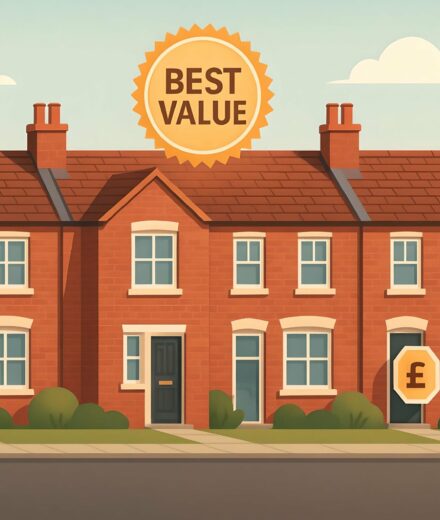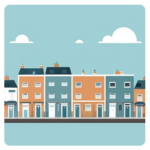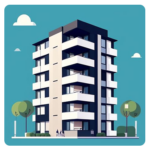

House Prices > Ipswich
| Year | Average Price | Transactions |
|---|---|---|
| 2025 (proj.) | £286,500 | 3,684 |
| 2024 | £280,300 | 2,759 |
| 2023 | £300,100 | 3,173 |
| 2022 | £299,800 | 4,003 |
| 2021 | £282,000 | 4,909 |
| 2020 | £265,800 | 3,388 |
| 2019 | £256,100 | 3,741 |
| 2018 | £247,300 | 3,812 |
The Ipswich property market has been simmering like a hearty stew on a Suffolk Sunday, with prices largely floating upwards from 2018 through to the present day, before taking an unceremonious dip in 2024, only to hint at a “just right” bounce in 2025. For anyone keeping an eye on local bricks and mortar, it’s been a journey with more seasoning than you’d expect for such a resolutely British town.
So what’s the core message? The Ipswich market moves with the calm predictability of the Orwell, but with just enough surprises to keep both investors and families guessing—not to mention, plotting their next smart move.
Searching for a place to settle? Ipswich has plenty of homes for sale that could suit you.

Avg. Property Price: £446,300
Avg. Size of Property
1,415 sq/ft
Avg. Cost Per Sq/ft
£329 sq/ft
Total transactions
1,864 (since 2021)

Avg. Property Price: £271,000
Avg. Size of Property
972 sq/ft
Avg. Cost Per Sq/ft
£286 sq/ft
Total transactions
3,087 (since 2021)

Avg. Property Price: £198,400
Avg. Size of Property
828 sq/ft
Avg. Cost Per Sq/ft
£244 sq/ft
Total transactions
3,285 (since 2021)

Avg. Property Price: £138,800
Avg. Size of Property
651 sq/ft
Avg. Cost Per Sq/ft
£216 sq/ft
Total transactions
483 (since 2021)
Ipswich’s property market, when split by property type, demonstrates a fascinating mix of ambition and practicality. Detached homes sit at the summit for both price and space, making them the indisputable choice for buyers with big dreams (and bigger deposits). For those acting fast, detached buyers display the same determination seen at Portman Road during derby day – reserved, premium, and clearly willing to go the distance for their quiet patch of Suffolk.
In stark contrast, flats and apartments make up the smallest slice of market activity by transactions. Prices are strikingly lower than any home with a garden or a gate, and size is more modest (exactly what you’d expect in city central postcodes where convenience and low maintenance trump square footage). The lower cost per square foot puts flats in sharp focus as the realistic stepping stone for solo buyers, commuting professionals, and anyone looking to sidestep the UK’s ferocious rental market. Even so, with transaction numbers in the hundreds rather than the thousands, flats hardly dominate the conversation – here, property hunters circle like seagulls after chips, but many never swoop in for the feast.
Moving up the rungs, semi-detached homes are a stalwart in Ipswich. Not only do they offer a balanced package of value and usable space, but their healthy sales volume shows that plenty of locals are happy to compromise a touch of privacy for the reliability of classic brick-built family living. And let’s not ignore terraced homes, which continue to be the heartbeat of busy neighbourhoods. Their approachable average price and compact footprint suit a wide spectrum of buyers, from young couples to seasoned landlords, making them a shrewd bet, especially when competition for space in more central parts of town heats up like a busy market morning.
Looking at cost per square foot across each property type, the hierarchy appears just as you’d expect: detached homes command the highest headline price, but work out cost-effective for those prioritising breathing space. Terraced and semi-detached houses settle comfortably in the middle, while flats bring the lowest buy-in – but also the tightest quarters.
For those wanting to get the full picture on recent price trends and market resilience, we recommend reviewing the latest Ipswich house price analysis.
| District | Avg Price (£) | Transactions |
|---|---|---|
| IP1 | £232,200 | 4,634 |
| IP2 | £214,900 | 2,982 |
| IP3 | £244,600 | 3,686 |
| IP4 | £258,300 | 4,678 |
| IP5 | £317,600 | 2,187 |
| IP6 | £309,600 | 2,749 |
| IP7 | £367,200 | 1,873 |
| IP8 | £323,200 | 1,566 |
| IP9 | £358,800 | 1,366 |
| IP10 | £422,900 | 262 |
Ipswich’s property market reveals a fascinating patchwork of district-level differences, with each postcode bringing its own personality to the stage. According to recent sale data, property prices range from the attainable to the downright exclusive, influenced by everything from local community vibes to the proximity of Suffolk’s blossom-filled countryside.
At the more accessible end, districts such as IP2 and IP1 continue to turn plenty of heads among value-focused buyers. These areas, within arm’s reach of the town centre, typically offer more affordable entry points and robust transaction numbers. For first-time buyers or those set on getting on the ladder without breaking the bank, finding a home in parts of Ipswich is now like finding a Cornhill parking space at lunchtime: tricky, but far from impossible.
Up the scale, the story shifts dramatically. Postcodes like IP10 and IP7 deliver average sale prices that are, frankly, eye-watering by comparison. Here, buyers are paying a considerable premium for that elusive blend of village quietude and rural views, with fewer sales ticking over each month. Demand has a different flavour here; it’s less a question of turnover, more about exclusivity and aspiration.
There’s plenty happening in the “middle ground” too. Suburbs such as IP4 and IP3 balance decent access to amenities with leafy streets and reputable schools, attracting families who want both convenience and a sense of community without reaching for the top tier. If you’re considering a move, these districts might hit that sweet spot where price meets lifestyle. At M0VE, we’ve noticed that homes in this bracket are snapped up faster than chips on Friday at Felixstowe seafront. For a closer look at what’s driving these pricing hotspots, see how Ipswich compares across its districts.
So, what’s the summary? Location, lifestyle, and prestige remain the three main levers shaping house prices in Ipswich's districts. Buyers must weigh up their priorities, whether searching for a foothold, planning a family future, or seeking that rare slice of Suffolk exclusivity.
Please also check out the following areas in Ipswich for further insights:
| City | Avg Price (£) | Transactions |
|---|---|---|
| Manningtree | £353,900 | 1,250 |
| Woodbridge | £383,100 | 3,349 |
| Harwich | £223,300 | 2,256 |
| Felixstowe | £289,700 | 3,205 |
| Stowmarket | £285,600 | 4,248 |
| Walton On The Naze | £247,400 | 1,069 |
| Frinton-On-Sea | £348,000 | 1,323 |
| Colchester | £315,200 | 21,195 |
| Clacton-On-Sea | £244,400 | 7,663 |
| Eye | £371,600 | 918 |
House prices near Ipswich bring out the town's unique flair. With wild swings from coastal bargains to esteemed commuter hotspots, Ipswich stands as a solid option in Suffolk’s ever-competitive scene. Buyers here aren't just choosing bricks and mortar, they’re picking from a patchwork of lifestyles. At M0VE, we’ve noticed the interest in Ipswich has taken on the feel of a local derby – everyone’s staking their hopes on getting the best pitch.
Looking east, places like Woodbridge and Eye command the region’s loftiest prices, showing off their period charm and that much-envied riverside tranquillity. Their exclusivity can price out first-time buyers, but families eager for quiet, leafy streets still snap up homes here. Then there are spots such as Harwich and Clacton-On-Sea, which undercut their neighbours considerably. These areas offer a classic seaside atmosphere and attract steady interest from buyers looking for value or investing in a coastal dream that doesn’t break the bank.
Meanwhile, Colchester powers ahead on sheer market activity, racking up thousands of transactions – a proper whirlwind, busier than the A12 after a Football League promotion. The convenience to London, plus strong schools and amenities, turns Colchester into a magnet for families and professionals. Felixstowe and Stowmarket also tick the boxes for substantial, lively markets. Demand is robust, supply is fairly diverse, and it feels like houses are snapped up before you can say “Suffolk brew.”
If you’re weighing your next step, buying here isn’t a quick dash. It’s a strategic game of chess in Ipswich’s bustling market. Stick with it and you might just find that perfect spot, right in the thick of Suffolk’s action.
Please keep in mind, this section focuses solely on average property pricing and overall transaction counts.
This data leaves out property sizes and square foot costs, so full trends might not be visible. See more detail at our blog. Thank you.
Using a blend of official property records and custom corrections, we clean up distortions and produce pricing that’s easy to understand, wonderfully relevant and genuinely practical.
Our site uses cookies. By using this site, you agree to the Privacy Policy and Terms of Use.